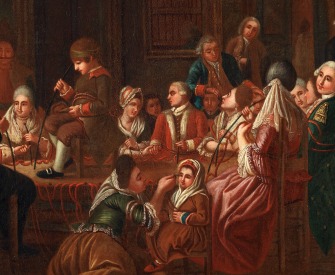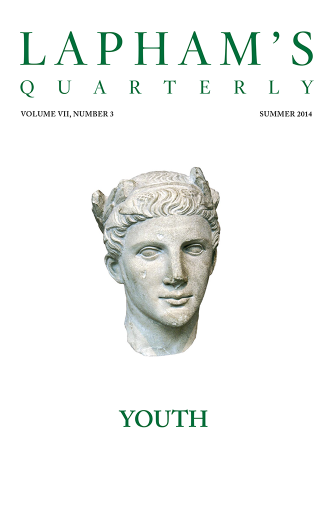We have to distrust each other. It is our only defense against betrayal.
—Tennessee Williams, 1953Rogue Wounds
Playing ill or feigning madness has been a con for hundreds of years. But can a fake sickness become a real sickness?
By Daniel Mason
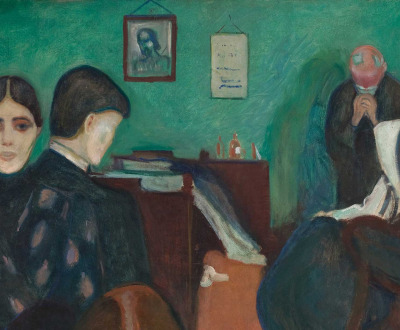
Death in the Sickroom, by Edvard Munch, 1893. Wikimedia / Munch Museum.
In March 1876 Dr. Carlos MacDonald, newly appointed medical superintendent of the State Asylum for Insane Criminals at Auburn, New York, received word that a new prisoner was convulsing. He found the man on the floor of the ward, “his face distorted and livid; frothy saliva, tinged with blood, was oozing from his mouth…while an attendant and two patients were holding his limbs to prevent him from self-injury.” The seizure proceeded, rigidity gave way to spasms, the man’s head hammered against the ground. But the doctor thought something was amiss. Crouching in the darkened room, he saw the prisoner’s thumbs were clenched outside his fists. He took the man’s hands in his, pried them open, and watched them close. The nails were pink. A glance at the man’s pants revealed “no visible indications of relaxed sphincters.” The man opened his eyes, gazed about, and proceeded to convulse again. The seizures lasted an hour. The prisoner fell asleep and MacDonald departed, although not before proclaiming him a fake.
By that point in his career, Carlos MacDonald was well acquainted with cases of feigned epilepsy, having already served at the New York State insane asylum at Flatbush. There was little that day to suggest this case was any different. The prisoner, one James Clegg, had recently been moved to Auburn from Sing Sing, where inmates often malingered to get themselves transferred to the comparative comfort of a hospital. But Clegg, it turned out, was a feigner like none other. When at last, after more observation, questioning, and outright threats, MacDonald forced a confession, the prisoner could not contain his admiration. For fifteen years Clegg had studied seizures from books and true epileptics, he told MacDonald, “but you are the first doctor that ever tumbled to me.” And then, either as a reward, or out of the realization that his doctor might prove some use to him, Clegg told his story.
James Clegg was a native of Manchester, England; early thirties, unmarried. He had parted swiftly from the devout ways of his parents, embarking on a life of vice and crime. At age sixteen he fell in with a gang of pickpockets with a particular hustle called “dummy chucking”—street slang for feigning a fit. Clegg had found his calling. Soon, he was traveling the English countryside, chucking dummies while an accomplice picked the pockets of curious onlookers. He chucked dummies in churches and at funerals; arrested, he “chucked a beautiful dummy” in court and was released. Later, convicted of a stabbing and destined for solitary confinement at Milbank, he chucked a dummy and was transferred to the more pleasant airs of Chatham. He chucked again and was sent to Woking, then Dartmoor, Parkhurst, all along the way chucking himself into lighter labor and more benign treatments, until he landed a daily prescription of a pint of porter “to keep up his strength.” It was almost too good to be true. Fearing the doctors might catch on to the ruse, he chucked a dummy from the third tier of cellblocks, splitting his scalp and knocking himself unconscious for twelve hours. At last, freed from prison, he lit out for America, and he might have had the whole continent before him had he not committed a burglary and been sent to Sing Sing, then Auburn, and the doctor who would finally bring his seizures to a halt.
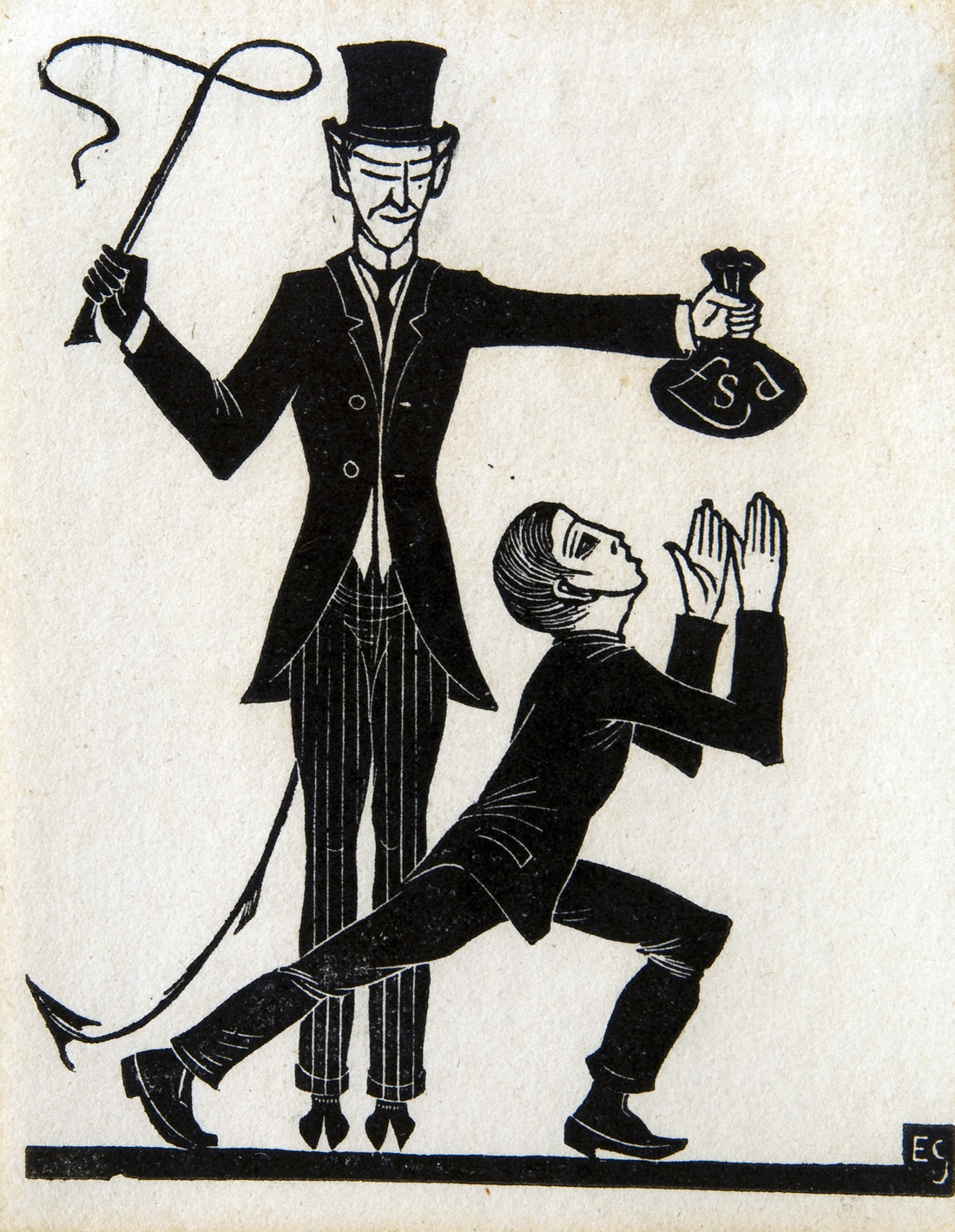
The Money Bag and the Whip, by Eric Gill, 1915. © Private Collection, Bridgeman Images.
MacDonald published “Feigned Epilepsy: Case of James Clegg, alias James Lee, ‘The Dummy Chucker’” in The American Journal of Insanity in July 1880. The doctor was clearly taken by his patient, and it wasn’t long before he found himself under Clegg’s wing, learning the ways of the chucker, how he slit his tongue before an attack, mimicked the “epileptic cry,” convulsed. Soon Clegg was performing his act before medical visitors, while the men debated the signs and symptoms. Was the thumb inside or out? Were the nails pink or livid? Were the trousers clean? It was all very colorful, but the medical implications of the case were grave. After all, diagnosing feigned epilepsy required knowing what true epilepsy was, no small task some fifty years before epileptiform spikes would be observed on electroencephalograms.
And yet the case of James Clegg presented more than just a challenge for medical diagnosis: at stake in his exposure was nothing less than medical authority itself. In his own treatise on feigning, the Greek physician Galen wrote that Truth—alitheia, literally the “unhidden”—was the doctor’s duty. For fifteen years, Clegg had deceived doctors of hospitals, asylums, and prisons. Over a millennium and a half had passed since Galen described a slave feigning a knee wound so as to remain with a lover, and medicine had yet to rid itself of fakery. Indeed, it is possible to follow much of medicine’s evolution through its changing reaction to feigned illness. There are few conditions that have not been fabricated, from the goriest self-inflicted wounds to the ineffable afflictions of the mind. Feigning has accompanied the professional expansion of medicine into legal and military matters, such as insanity pleas in murder trials and soldiers’ pension evaluations. It has driven the discovery of new symptoms and signs, new categories, even entirely new conceptions of illness. And nowhere is this as true as it is in psychiatry, where the specter of simulation haunts, I believe, our very deepest understanding of what it is to be mentally ill.
Three hundred years before James Clegg threw himself from the third-story cellblock, Ambroise Paré, the great surgeon of the French Renaissance, was visiting a colleague on the outskirts of Paris, when they were approached by a beggar woman, who lifted her skirts to reveal a prolapsed rectum. It was a horrid sight, over half-a-foot long, leaking a pus-like fluid over her legs and garments. But Paré’s companion, Doctor Flecelle, thought she looked too healthy to be suffering from such a wound. Filled with “a just anger”:
he ran upon her and threw her down up on the ground, and trod her under his feet, and hit her diverse blows upon the belly, so that he made the gut, which hung at her, to come away, and by threatening her with more grievous punishment, made her confess the trickery, and that it was not her gut, but of an ox, which being filled with blood and milk, and tied at both ends, she put the one of them into her arse, and let the filth flow forth at very little holes.
Nor was this the only “hedge-whore” to merit Paré’s righteous ire and earthy prose. In Vitré, his doctor-brother Jean, had met another caignardiere who glued a frog-skin to her breast to feign a tumor; a “big fat-bum’d wench of Normandy” claimed to have a snake in her belly; outside a church in Angres, a “base scoundrel” stuck a dead man’s arm in his sleeve and pretended it was his own.
It was with such rogues that Paré resumed the discourse on feigning that Galen had begun in the second century, only to disappear, like so much in medicine, during the Middle Ages. But why was the surgeon to four French kings bothering himself with declaiming beggar women? The most immediate answer was the superstition that the sight of a “hospital beggar” could cause a woman to conceive a monstrous child. In his Works, Paré’s discourse on begging appears in the chapter On Monsters, amid prints of four-legged babies and a fetus with the face of a frog. Beggars also threatened to upend the normal structure of charity by distracting attention from those with genuine illness. But even more dangerous was the threat of vagabondage to society at large. For Paré, feigning was but the vanguard of a broader French underworld, “apt at exercising the pimp and bawd trade, at strewing poisons throughout towns and cities, committing treason and serving as spies, at stealing, at highway robbery, and every other wickedness that one might practice.” Thus the role of doctor as protector of social order. Without the clinical skills of Dr. Flecelle, Paré, and colleagues, such evils could spread unchecked, like the very cancers such “scoundrels” feigned.
Certainly deception appeared to be everywhere. Like James Clegg, the beggars even specialized in their deceits. In Paris, piètres pretended lameness, sabouleux threw fits (chewing on soap—savon—to mimic the epileptic’s foaming mouth), while hubains feigned mad-dog bites (for which one prayed to St. Hubert). In Germany, such figures appeared as early as 1494, stooping and limping through Sebastian Brant’s classic Ship of Fools with their rags and cultivated wounds. In Italy, Il Vagabondo, a taxonomy of beggars written in 1621 by an Italian friar, went through fourteen editions. It contained thirty-eight species of beggars, many of whom were specialists in simulation: alacrimanti (weeping), ascioni (imbecility), accaponi (wounds), or accattosi (madness from being locked up in Turkish prisons.)
Perhaps nowhere was the diversity of feigning as rich or literarily pervasive as it was in England. There, Il Vagabondo found an English counterpart in Thomas Harman’s A Caveat or Warening for Common Cursetors Vulgarely Called Vagabones (1566), filled with sham epileptics, “dummerers” feigning mutism, and “Abraham men” who claimed to have been interned in the London madhouse of Saint Mary of Bethlehem, or Bedlam.
Of the colorful cast of English feigners, it was the Abraham man, or Mad Tom, who would prove to be the most durable. In King Lear, when Edgar flees his father’s wrath, he disguises himself as one of these Toms of Bedlam,
who, with roaring voices,
Strike in their numb’d and mortified bare arms
Pins, wooden pricks, nails, sprigs of rosemary;
And with this horrible object, from low farms,
Poor pelting villages, sheep-coates, and mills,
Sometime with lunatic bans, sometimes with prayers,
Enforce their charity.
Those cultivated wounds, those mortified arms. Here too the magical fear of the madman’s bans (or curses), an English counterpart to Paré’s superstitions about the power of a beggar to cause a monster birth. Here too the rootless wandering. But Edgar-as-Tom is far more tragic, far more complex, than Paré’s rogues. Indeed, in the context of the literature of the age in which it was written, King Lear evinces a sympathy for the mad and homeless that appears nearly revolutionary. A force of comfort for the bereft King while the tempest rages outside their hovel, Edgar-as-Tom never issues his curse. For Shakespeare, here, the poor can play poorer and the mad madder, but this artifice is all they have left.
Over the course of the seventeenth century, Tom of Bedlam would become the subject of numerous popular ballads, at times portrayed with the pathos of Shakespeare but mostly celebrated for his chicanery. In “The Cunning Northern Beggar,” the antihero, “like Proteus often changing,” lugs a crutch, crawls, tucks a leg to feign an amputation, faints, paints sores on his skin, walks behind a boy in the manner of the blind, and dabs blood on his face to suggest the same “falling sicknesse” as James Clegg.
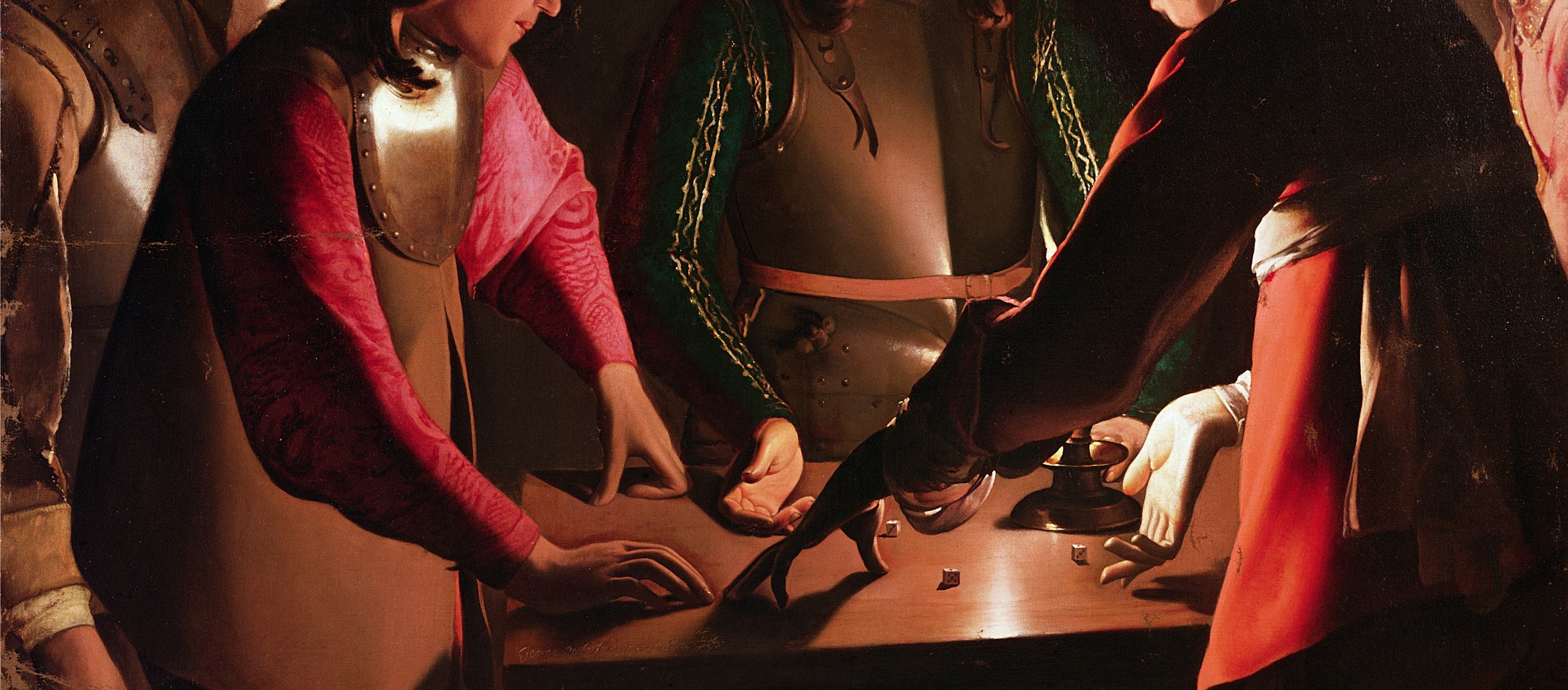
The Dice Players, by Georges de La Tour, c. 1650.
He also faked that he was a soldier, who in the “warres bin maymed.” There were good reasons to choose this guise. The wounded soldier evoked a complex mix of pity and fear—one palm outstretched for alms, the other lingering ominously inside his cloak. Furthermore, in an age when national and local authorities were trying to crack down on vagabonds, soldiers were granted the privilege of begging as they made their way home from war. In Elizabethan England, frequent cycles of conscription and disbandment rendered the begging soldier a more familiar sight. “Freshwater sailors,” Harman called them cynically, whose “ships were drowned in the (inland) playne of Salisbury.” Since soldiers were generally conscripted from the poor and propertyless, such men, who had little when they left to fight, returned with even less.
The malingering beggar, then, slipped easily into the mass of real veterans, who themselves made up an increasing proportion of the homeless poor. In England, Parliament tried to cope with its “masterless men” through a series of Poor Laws, which for the most part shifted the responsibility of discipline and charity onto the parish. But as the seventeenth century drew on, large-scale war, whether on the Continent or at home, meant the State was increasingly involved in veterans’ affairs. This meant not only separating the freshwater sailors from true veterans but also screening soldiers upon enlistment and assessing them for pensions upon demobilization. Both situations were ripe for exploitation. Once again, medicine found itself faced with the question of simulation.
That soldiers play ill to avoid fighting was hardly new: Odysseus feigned madness in an attempt to avoid sailing for Troy and leaving behind his wife and son. One old etymology of the word poltroon, that insult now disappointingly rare, held that it came from pollice truncus, or severed thumb, in reference to a ploy to avoid conscription. The etymology may be inaccurate, but the phenomenon is ancient. Suetonius wrote of a knight amputating two sons’ thumbs to save them from service, and it was considered enough of a problem in the late Roman Empire that corporal punishment for such evasion was written into the Theodosian Code. But during the Revolutionary and Napoleonic Wars in France, with their unprecedented levels of conscription, malingering reached epidemic proportions. Feigning disease, wrote François-Emmanuel Fodéré of the revolutionary Alpine Army, had been “brought to such perfection as to render it as difficult to detect a feigned disease as to cure a real one.” If battlefield casualties weren’t enough, the field surgeon also had to cope with masses of men desperate to get home by any means. There even arose a small industry of doctors, many fraudulent, who counseled men on how best to feign.
It was around this time that the word malingerer entered the English language, and until the mid-nineteenth century it was used almost exclusively in a military setting. Indeed, surveying the literature, one might call it the Age of the Great Military Malingering Monograph, with descriptions of various forms of morborum fictione, maladies simulées, and factitious diseases. There are many such medical treatises, most beginning with a reference to Odysseus and then progressing through all the conditions encountered by the military doctor. These ranged from feigned headache and dizziness to more exotic conditions such as polyps of the nose (soldiers used rooster testes) or the vomiting of blood (a razor across the tongue would do the trick), to more outlandish acts of feigning animals in the stomach or even death. The treatises pilfered from one another until 1843, when Scottish surgeon Hector Gavin surveyed the field with such exactitude that future monographs came to rely primarily on him. Yet some cases were not without local flair, revealing much about the war and medicine of the times. Self-poisoning with mercury should be suspected if a soldier’s blood killed all his leeches. A particular bane of French Revolutionary Forces were soldiers who knocked out their own incisors, thereby limiting their ability to tear open powder cartridges.
He that will cheat you at play, will cheat you any way.
—Thomas Fuller, 1732Among cases of the self-blinding in Muhammad Ali Pasha’s army in Egypt and the epidemic of palpitations among the English Marine Artillery (brought on by white hellebore, only sixpence for a dose), one category of illness drew particular attention. “There are few diseases easier and more convenient to simulate than madness, mania, ecstasy, etc.,” wrote Baron Percy, chief surgeon of the Grand Army of Napoleon, in his contribution to “Simulation” in the 1821 Dictionnaire des Sciences Medicales. No red badge was needed to prove insanity, and in the years before mass institutionalization of the mentally ill, most soldiers were familiar with madness from daily life. Mental illness offered the doctor a chance to show his expertise: it didn’t take much training to find a razor hidden beneath a sailor’s tongue, but diagnosing madness required extensive experience. It was here that malingering monographs dwelled, discussing the importance of taking account of disease evolution, family history, alcoholism, temperament, and current life-circumstances, with a patience and forbearance that is hard to imagine in a garrison hospital near the front.
Despite these efforts, writers often threw up their hands, in part for the same issues that plagues psychiatric taxonomy today—diagnosing feigned madness means knowing what true madness is. How was one to distinguish between the many French soldiers punished for “false nostalgia” by being forced to drink noxious potions until they gave up their deception and the “country lad” from the Fens of Lincolnshire, who died of “nostalgia” on his way to serve in Canada? Or the young man who developed “somnolency combined with mental hallucinations” on the African coast: was he feigning or suffering the symptoms “extreme grief and fear?” Did the soldier described in 1828, who severed his Achilles tendon after twenty-six years of excellent service and with a pension already guaranteed, “deliberately” maim himself? And what if, as one French doctor wrote, long-term simulation of insanity may in itself bring about real disease?
Of all the insanities, perhaps the most troubling for theorists of malingering were those that sat at the threshold of body and mind. Of these, the most famous was hysteria. Given the breadth of its symptomatology, ranging from contorted limbs to shortness of breath to the delirium of possession, the fact that hysteria endured as a clinical entity for over two thousand years is itself remarkable. In a classic Renaissance formulation by Thomas Sydenham, its irregularity was its very hallmark. By the Age of the Great Military Malingering Monograph, various theories had come and gone—in Hippocrates there was the notion of a wandering womb; subsequently it was attributed to vapors, passions, or disorders of the nerves. What always remained was its chameleon ability to imitate anything. Blindness, muteness, epilepsy, pain—all could be due to hysteria. And hysteria itself could be feigned. In the entry on “Feigning Disease” in the Dictionary of Practical Medicine (1833), a case of flank pain was considered by one doctor to be “neuralgia,” another, “hysteria,” a third, “uterine irritation,” a fourth, “deception probably connected to hysteria,” and a fifth “spinal irritation.” One yearns for the simplicity of the soldier with rooster testes in his nose.
Given the historical understanding of hysteria as a female malady, simulation of hysteria was not initially considered a problem in military men. “The appearance of symptoms simulating such an affection in a soldier,” wrote the Scottish surgeon Gavin in his grand survey, “would excite the utmost suspicion: we might almost as readily expect to find them suffer the pains of labor, or the effects of protracted suckling.” World War I exploded this notion. In England, following the first reports of “nervous and mental shock” in December 1914, the War Office found itself unequipped to tend to psychiatric wounds. By 1916, 40 percent of English casualties were due to “nervous disorders,” whether called shell shock, battle fatigue, soldier’s heart, or war neurosis. For the Hungarian psychoanalyst Sándor Ferenczi, the war presented a “veritable museum of hysterical symptoms.” Despite the great medical, financial, and political consequences for soldiers and the armies in which they served, the cause and treatment of such illnesses remained mysterious; just as they would be more than twenty-five years later when Lieutenant-General George S. Patton famously lost his command for striking two “nervous” soldiers in field hospitals in Sicily; just as they still are for sufferers from post-traumatic stress disorder today. What is clear, however, is that all of a sudden, between the soldier who lost his leg to a landmine and one who shammed a limp, a new patient had appeared, a third man without a visible wound, but whose legs simply wouldn’t move.
It is a wonderful turn of fate,” wrote the British psychiatrist W.H.R. Rivers in 1922, “that just as Freud’s theory of the unconscious and the method of psychoanalysis founded upon it should be so hotly discussed, there should have occurred events which have produced on an enormous scale just those conditions of paralysis and contracture, phobia and obsession, which the theory was especially designed to explain.”
Freud’s theory of the unconscious had emerged thirty years earlier out of observations on hysteria, when it was still primarily a female disease. Studying under the Parisian neurologist Jean-Martin Charcot, Freud was struck by the symptoms exhibited by women examined under hypnosis before a weekly audience at the Salpêtrière. Dutifully dissecting his patients when they died, Charcot failed to find a physical lesion, prompting him to describe a “functional” problem of the nerves, like an engine of flawless construction that misfires when you turn it on. Soon Freud and others disagreed: if hysteria was an attack of the nerves, it should obey the distribution of the nerves. That it did not implied a different origin: in life experience, memory, and ultimately, as Freud’s theory matured, in desire.

The Money Bag and the Whip, by Eric Gill, 1915. © Private Collection, Bridgeman Images.
As hysteria moved out of the domain of neurology and into psychiatry, it brought along its reputation as a duplicitous shape-shifter. “A malingerer who does not lie,” wrote one author in 1904, defining a hysteric. One of the enduring accusations against the hypnotic performances at Salpêtrière was that they were just that: performances. When Anna O., the first patient of psychoanalysis, looked back on the paralysis, fits, and other perplexing symptoms that had appeared while she was tending to her dying father, she wondered whether “she had not been ill at all and that the whole business had been simulated.” And not only patients were under suspicion. As Freud wrote in his obituary of Charcot, the discredit extended to the physicians who cared for them as well. It is not surprising that Anna O.’s doctor, Josef Breuer, dismissed her self-doubt regarding simulation as “a childish fear,” given the implication that he was either gullible or complicit in the deception.
Freud, however, would later come to integrate simulation into his theories. In 1920, called as an expert witness in a trial of wartime medical abuses, he defended a soldier accused of malingering by attempting to embrace the word itself. “All neurotics are malingerers,” Freud testified, his irritation manifest even in the century-old transcripts of the trial, “they simulate without knowing, and this is their sickness.” Whether in cases of “neurosis” or “hysteria,” the presence of performance did little to defuse the seriousness of the disease. In the darkest moments of mental illness, the sense of simulation could even be an ominous indication of lethality. Writing of his deep depression decades later, William Styron described “a theatrical quality” to his illness: “as I went about stolidly preparing for extinction, I couldn’t shake off a sense of melodrama—a melodrama in which I, the victim-to-be of self-murder, was both the solitary actor and lone member of the audience.”
This vision of the self—actor and audience, deceiver and deceived—would prove ever more influential as psychiatry developed. Many of the classic defense mechanisms described by Freud and his successors involve some kind of self-deception: the conversion of mental symptoms into physical ones is, after all, a deceit played upon the body by the mind. But we may lie about the source of our mental symptoms too. We tell ourselves that we despise what we actually desire. We fantasize. We distort. We think we are angry at a child when we are angry at a spouse, or at a spouse when we can’t bear yelling at a child. We deny emotions or project them onto others. Even when we are not ill, we tell ourselves lies about our achievements, our relationships, our invincibility. And we lie, in part because, like James Clegg, deception keeps us safe.
In the asylums, the garrison hospitals, the rogues’ hovels, and so on back through time, it is possible to see medicine moving toward this moment, when the malingerer ceases to be a monster and becomes a mirror to ourselves. Shakespeare sensed this long ago. “I will keep still with my philosopher,” says Lear, naked now, before Edgar-as-Tom. Edgar, despite his deceptions, has become the only honest man. At one time the King might have questioned whether the beggar was truly mad. But this question is the privilege of the healthy. You and I may ask it now, but carefully. For who knows what will happen when our moment comes? When we are cast to the heath, or called to war, or to a dying parent’s bedside? Will our feet give out beneath us, will our hands tremble, will our truths still hold?

